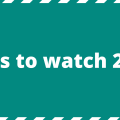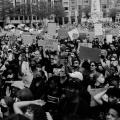
Campaigning in 2021
Among Dutch political parties, social media are more important than ever in the current corona period: the election campaign is largely digital. Social media has emerged rapidly in recent years. They are active media: users create content themselves and adapt other people's content. In addition, messages circulate quickly because users forward them to each other. The parties use Twitter, Facebook and Instagram, among others. TikTok is a relatively new social medium that can be added to this list. How do political parties use social media?
First of all the practical matters. This overview includes the parties VVD, PVV, CDA, D66, GroenLinks, SP, PvdA, ChristenUnie, PvdD, 50PLUS, SGP, DENK, FvD and BIJ1, along with the social media Facebook, Instagram, Twitter and TikTok. The first three are now conventional media, while TikTok is growing enormously. The number of TikTok users grew by 149% in 2020 to 1.7 million. While Instagram is all about photos, TikTok is all about videos. More specifically: audio. Users can use audio from other videos for their own videos. In this way, trends arise, for example a dance to a certain song. The videos can be three to sixty seconds long. There are a number of issues surrounding TikTok, mainly related to privacy. For example, organizations such as the Consumers' Association believe that TikTok does not sufficiently protect children against potentially harmful content of videos and it is unclear which user data is collected. In the US, the Trump administration almost banned the app because of fears that data from American citizens would end up in Chinese hands.
TikTok explicitly does not allow political advertisements. The other media do; The UvA, for example, developed one for this purpose dashboard with data on the numbers of advertisements by the parties and their costs. It is also interesting to look at what the parties themselves post on their social media.
First of all, Facebook. All parties have a Facebook page, varying in the number of followers from around 7,400 (PVV and AT1) and 264,000 (FvD). The page of Geert Wilders has many more followers than the PVV, namely more than 400,000. On Facebook, all parties mainly share links to other channels, such as a news item or a live session on YouTube. In addition, a common denominator is that fragments of debates or interviews with MPs and candidates are shared. All parties also share messages from their candidates who speak out on a relevant topic. It is striking that the PVV mainly shares other messages on Facebook and adds a comment.
Almost all parties can be found on Instagram, only the PVV does not have an account. Geert Wilders well, with 171,000 followers. Not all parties have been verified by Instagram. This is a tool that allows Instagram to show that it is an account with a 'real' organization behind it. Many people see the verification as a kind of show of trust and it increases their status. Only 50PLUS and AT1 have not been verified. The number of followers varies from 522 (50PLUS) to 36,000 (VVD). It is striking that the VVD account is almost alone memes posts, which is a big difference from their Facebook page. D66 has a clear aesthetic, with the same color scheme in every post. The PvdA posts many points of view, which are always introduced by a video of an 'ordinary' citizen. Post further THINK almost exactly the same messages as on Facebook: including videos of the tour through the Netherlands and promotion of candidates. Almost all parties post photos of the physical campaign and positions, except the VVD, which only posts memes.
Twitter is a medium that mainly revolves around texts with a limited number of characters. Again, all parties have Twitter accounts, except the PVV. Geert Wilders on the other hand yes. The verification tool also exists on Twitter. Being here alone 50PLUS, FvD and AT1 not verified. 50PLUS has the fewest number of followers, namely 6700. The VVD has the most followers, namely 250,000. This does not include Geert Wilders; he has 855,000 followers. Twitter is characterized by a lot of retweeting: sharing other people's Tweets. All parties do this frequently. Usually they are Tweets in which the party leader takes a position or promotes something. GroenLinks and the FvD also retweet people who do not appear to be directly affiliated with the party. The parties also promote other channels on Twitter, such as a video on YouTube or a podcast on Spotify.
TikTok
Then TikTok. Does this medium offer something new compared to other media? Not all parties have discovered TikTok yet and none of the accounts have been verified. The VVD, SP, GroenLinks, THINK and the youth department of AT1 have serious accounts on TikTok, with the number of followers varying from around 70 (SP) to 23,000 (VVD). There is also a 'support page' for it FvD. The CDA and D66 have inactive accounts. The accounts of the VVD and GroenLinks are clearly aimed at young people, for example fragments of debates are posted with topics that are relevant to young people. Both parties follow (audio) trends and link their own content to them. That one is striking speech by Jesse Klaver about the need for a diverse cabinet is the most popular video from GroenLinks, while the VVD is particularly popular with TikToks with humor, such as a video of a 'stare down' between Mark Rutte and Rico Verhoeven. The SP has TikToks with verbatim positions and fragments interviews with Lilian Marijnissen. DENK also posts fragments of debates, but mainly vlogs of their tour through the Netherlands. The youth department of BIJ1 does not link its videos to viewpoints, but discusses more general social topics, such as refugees. At the same time, they also follow trends, such as using a popular audio.
The few Dutch parties that are on TikTok mainly focus on young people. This makes sense, since TikTok is especially popular among young people. And it's a smart move, since many of these young people will be voting for the first time this year.





